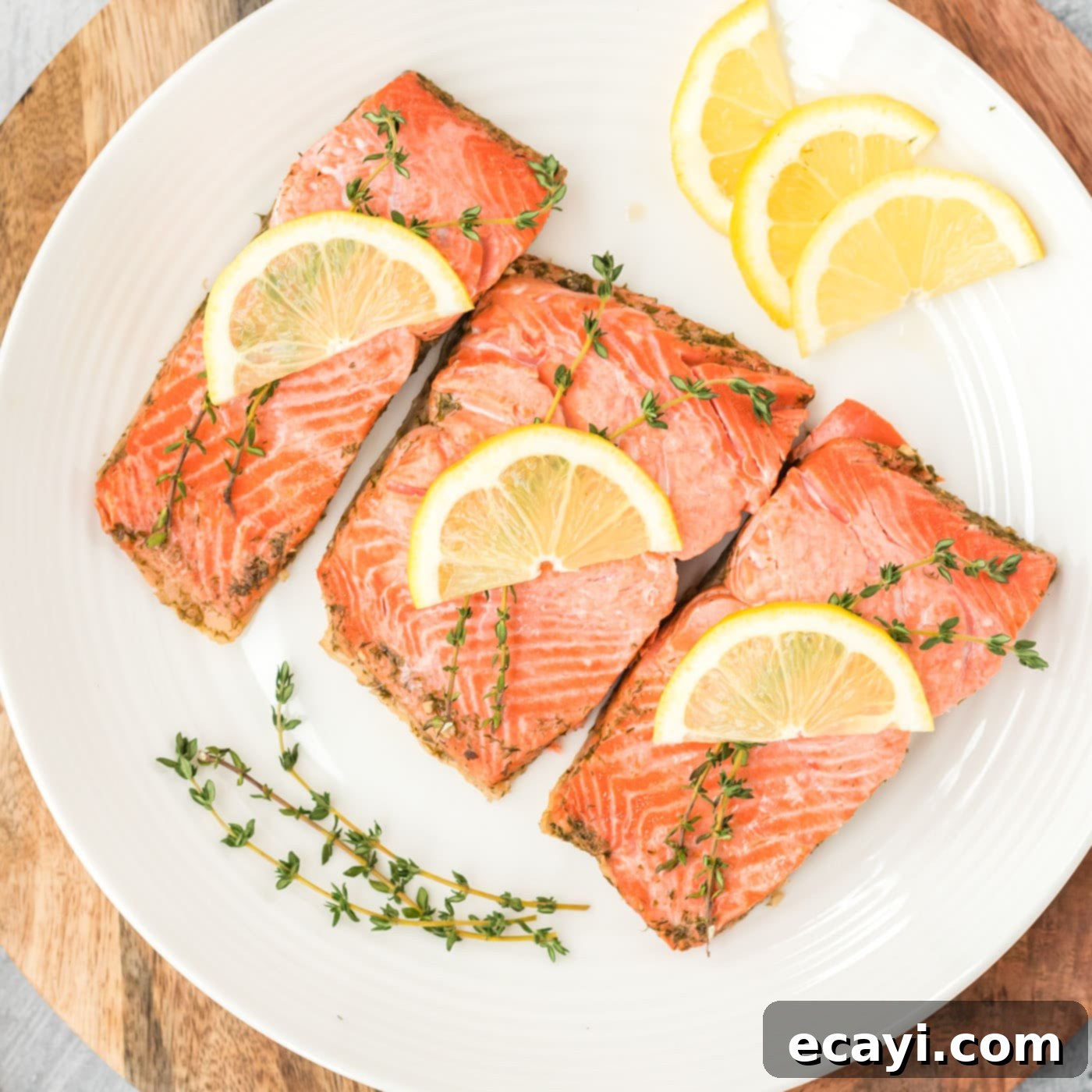Effortless Poached Salmon Recipe: Tender, Flaky, and Healthy Fish in Minutes
Discover the ultimate method for preparing perfectly tender and flaky salmon with this incredibly easy poached salmon recipe. Forget dry, overcooked fish; this technique guarantees succulent results every time, ready in just 8 minutes from start to finish! Poaching is a gentle and healthy way to cook, locking in natural flavors and moisture without the need for excessive fats. Whether you’re a seasoned chef or a kitchen novice, this guide will walk you through creating a delicious and nutritious meal that’s as impressive as it is simple.
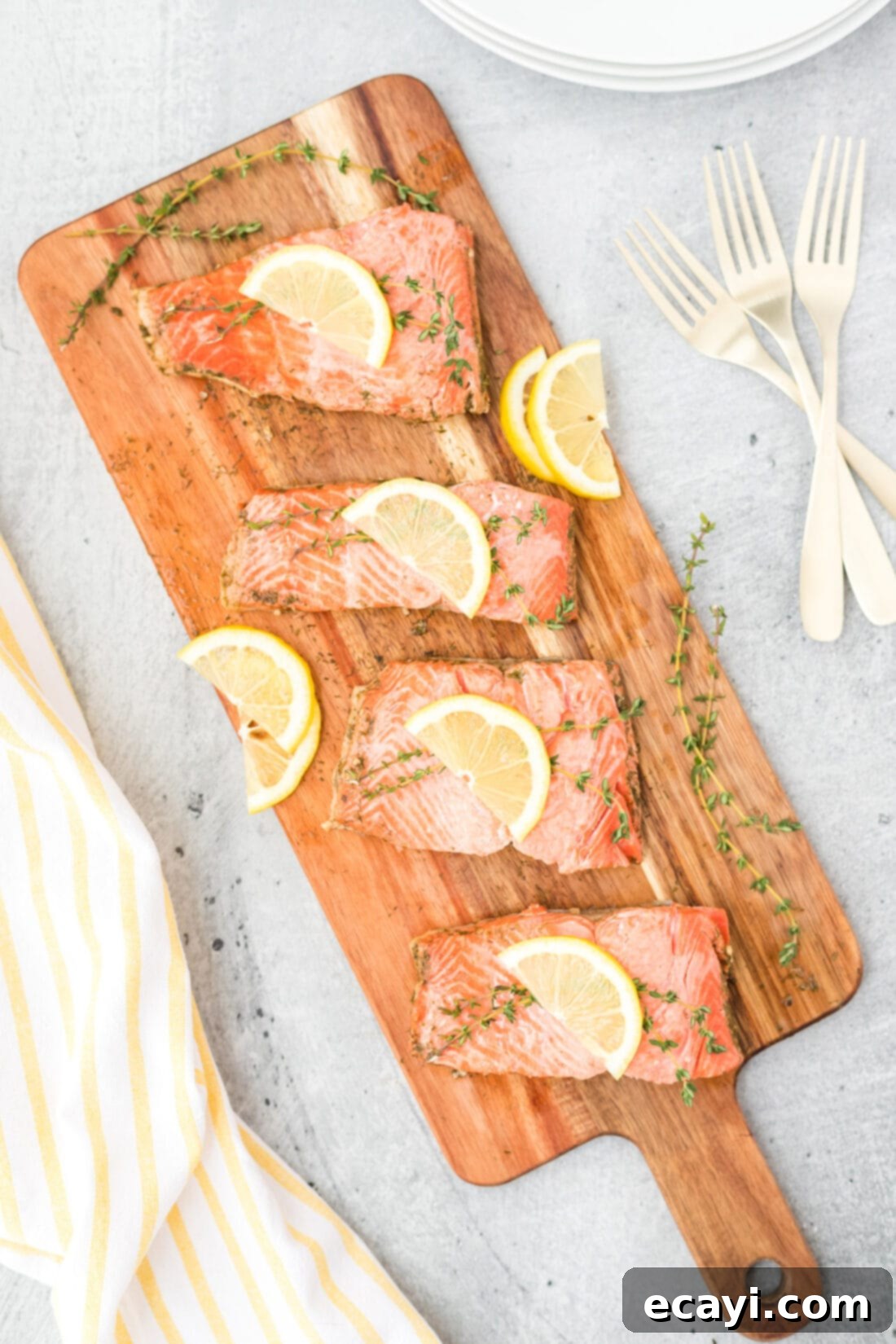
Why This Simple Poached Salmon Recipe Is a Game Changer
Poaching isn’t just a cooking method; it’s a culinary secret for achieving perfectly supple, flaky salmon. By gently cooking the fish in a flavorful liquid just below boiling point, we ensure it retains all its natural moisture and delicate texture. This method is especially effective for delicate foods like fish, where high heat can easily lead to dryness and toughness. The beauty of poaching lies in its ability to infuse the salmon with a myriad of flavors from the poaching liquid, transforming a simple fillet into a gourmet experience without any fuss.
Beyond its delicious results, poaching stands out as one of the healthiest ways to prepare salmon. Unlike frying or pan-searing, it requires no added butter or oil, making it an excellent choice for those mindful of their dietary intake. Salmon itself is a powerhouse of nutrition, rich in omega-3 fatty acids, protein, and essential vitamins. Poaching preserves these beneficial nutrients, offering a wholesome meal option.
Moreover, poached salmon is incredibly versatile. Its mild, tender profile makes it a fantastic base for various culinary creations. You can serve it simply with a squeeze of lemon and fresh herbs, or get creative. It’s an ideal ingredient for whipping together a vibrant salmon salad, similar to a classic tuna salad but with a richer flavor profile. It also makes for superb fish cakes, flaky salmon wraps, or as a protein boost in pasta dishes. The gentle cooking process ensures it flakes beautifully, making it easy to incorporate into other recipes.
This recipe provides a foundational approach, allowing you to customize the poaching liquid with your favorite aromatics and spices. This adaptability means you can enjoy perfectly cooked salmon repeatedly without ever getting bored. It’s quick, healthy, and consistently delicious – a true triple threat in the kitchen.
Related Recipe: Enhance your salmon with a creamy, herby delight – try our Rosemary Cream Sauce for an extra touch of elegance!
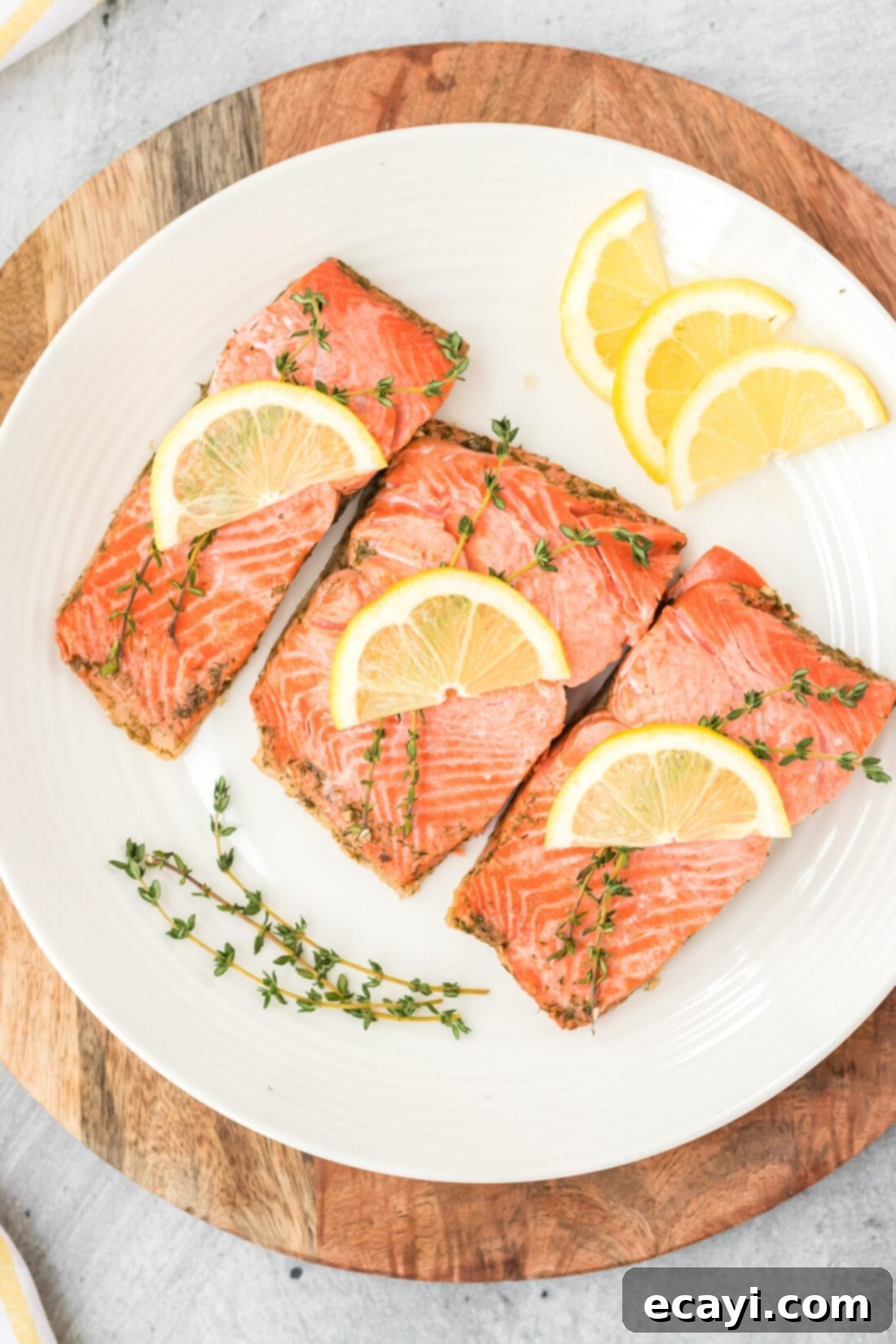
Essential Ingredients for Perfect Poached Salmon
Crafting delicious poached salmon starts with a few simple, fresh ingredients. The beauty of this recipe is that you likely already have most of these staples in your pantry. For precise measurements, a comprehensive list, and detailed instructions, remember to check out the printable recipe card located at the very end of this article.
Here’s what you’ll need to create your tender, flavorful salmon fillets:
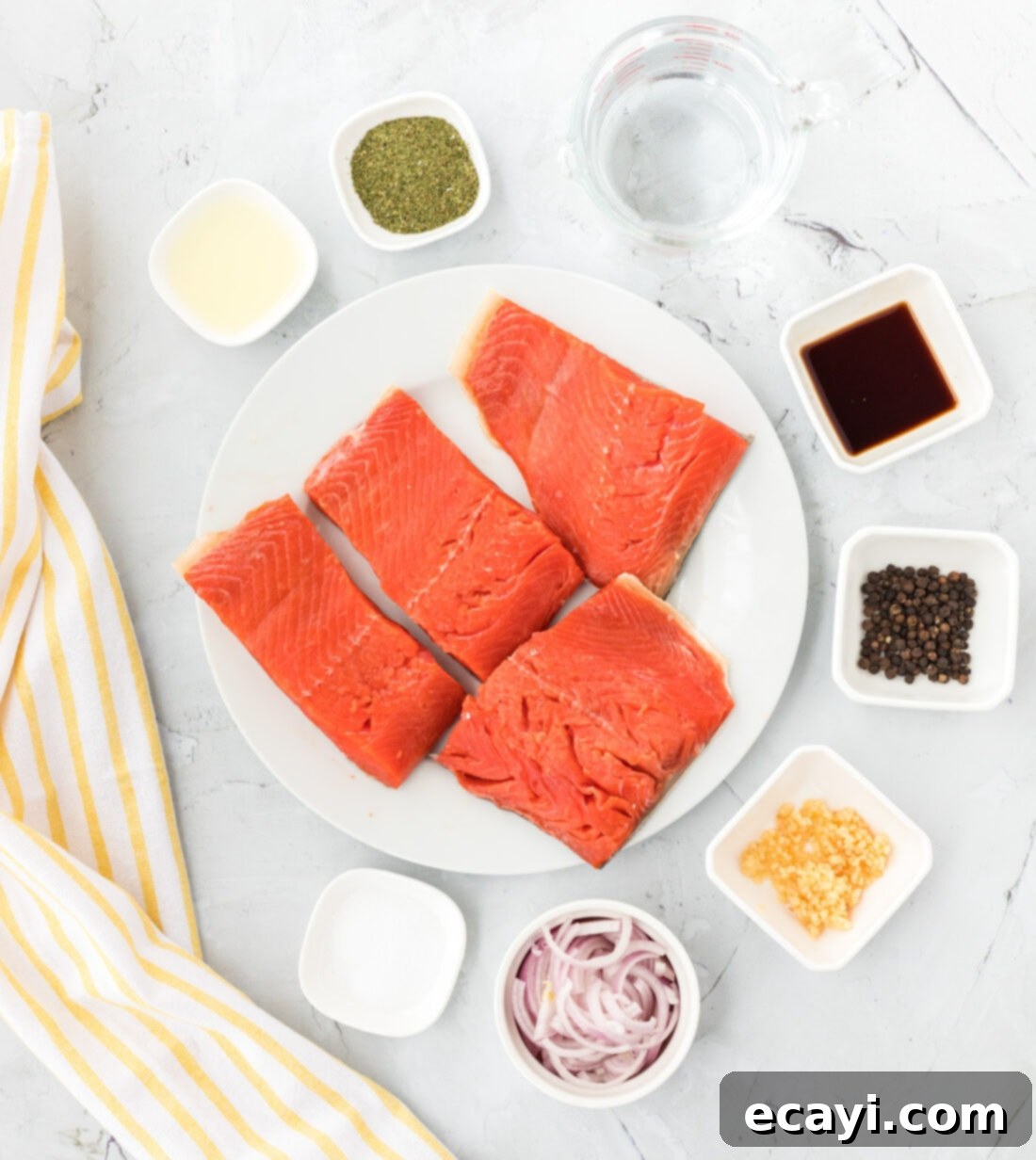
Ingredient Spotlight & Smart Substitutions
Understanding the role of each ingredient and knowing how to make smart substitutions can elevate your cooking experience and ensure successful results every time. Here’s a deeper dive into the components of our poached salmon recipe:
- SALMON: We specifically used Sockeye salmon for this recipe, which is known for its vibrant color, firm texture, and relatively thinner fillets compared to other varieties. If you opt for Sockeye, you’ll enjoy a quicker cooking time, typically around 2-3 minutes. For thicker salmon varieties like King, Coho, or Atlantic salmon, you will need to increase the cooking time to about 5 minutes to ensure it’s thoroughly cooked through. Always aim for fresh, high-quality salmon fillets, preferably skin-on, as the skin helps hold the fish together during poaching and can be easily removed afterward.
- Poaching Liquid Base (Water): While water is the foundational liquid for this recipe, offering a neutral base that allows the other aromatics to shine, feel free to experiment. You can substitute half or all of the water with vegetable broth, chicken broth, or even a dry white wine for added depth of flavor. A mix of water and wine (or broth) is often a favorite.
- Dried Dill: Dill is a classic pairing with salmon, offering a fresh, slightly tangy, and herbaceous note. If you have fresh dill on hand, a sprig or two will work wonderfully and often provides a more vibrant flavor than dried. Adjust quantity to your taste.
- Shallot (Sliced): Shallots contribute a delicate, sweet onion flavor that is less pungent than a regular onion. If you don’t have shallots, a very thin slice of red onion or a tiny amount of finely minced yellow onion can be used as a substitute, but use sparingly to avoid overpowering the salmon.
- Lemon Juice: Fresh lemon juice is crucial. It brightens the flavor of the salmon and the poaching liquid, adding a necessary acidic balance. Freshly squeezed is always best. If you don’t have fresh lemons, bottled lemon juice can work in a pinch, but the flavor might be less vibrant.
- Salt and Black Peppercorns: These are your basic seasonings. We recommend using whole black peppercorns in the poaching liquid as they release their flavor slowly and elegantly without making the liquid cloudy. You can use freshly ground black pepper to season the salmon directly after poaching for a fresher kick. Adjust salt to taste, especially if using a salty broth.
- Minced Garlic: Garlic adds a foundational aromatic note. Freshly minced garlic provides the best flavor, but pre-minced garlic from a jar can be used for convenience.
- Liquid Smoke: This is an optional but highly recommended ingredient. Just a tablespoon of liquid smoke imparts a subtle, smoky essence to the salmon, mimicking some of the flavors you’d get from grilling or smoking, without the need for specialized equipment. It adds a unique depth that complements the fish beautifully.
When selecting your salmon, look for fillets that are firm, moist, and have a vibrant color. Avoid any fish that smells overly fishy or has dry edges. Freshness is key to the best-tasting poached salmon!
Step-by-Step Guide: How to Make Perfect Poached Salmon
These step-by-step photos and instructions are here to help you visualize how to make this recipe with ease. While this section provides a detailed walkthrough, you can Jump to Recipe to get the printable version of this recipe, complete with exact measurements and succinct instructions, at the bottom of the post.
- Prepare the Poaching Liquid: Begin by gathering a large skillet that is wide enough to accommodate your salmon fillets in a single layer without overcrowding. This ensures even cooking. Add all the ingredients for the poaching liquid – including the dried dill, sliced shallot, water, lemon juice, salt, black peppercorns, and minced garlic, along with the optional liquid smoke – into the skillet. Place the skillet over medium-high heat and bring the mixture to a gentle boil. The goal here is to allow the aromatics to meld and infuse the water, creating a flavorful broth for your salmon.
- Gently Poach the Salmon: Once your poaching liquid reaches a boil, carefully add the salmon fillets to the skillet. Ensure they are submerged in the liquid. Immediately reduce the heat to medium. This is crucial for gentle poaching, as a rapid boil can cause the salmon to cook too aggressively and potentially fall apart. Cover the skillet with a lid. Covering helps trap the steam, ensuring the salmon cooks evenly and stays moist. Cook for 2-3 minutes if using thinner Sockeye salmon. If you’re using a thicker variety of salmon, such as Atlantic or King, extend the cooking time to about 5 minutes. The salmon should be cooked through but still tender and moist.
- Serve Immediately: As soon as the salmon is cooked to your desired doneness, turn off the heat. Using a fish turner spatula – a wide, thin spatula perfect for delicate fish – carefully lift the poached salmon fillets out of the liquid. Transfer them to a warm platter or individual plates. The fish turner helps prevent the flaky salmon from breaking apart. Serve your perfectly poached salmon immediately with your favorite sides and garnishes.
Frequently Asked Questions & Expert Tips for Poached Salmon
Salmon is considered perfectly cooked when it reaches an internal temperature of 145°F (63°C). To ensure accuracy, insert an instant-read thermometer into the thickest part of the fillet. At this temperature, the salmon will be flaky, tender, and moist.
To maintain freshness, store any leftover poached salmon in an airtight container. Keep it in the refrigerator, and consume within 2-3 days for the best quality and safety.
Yes, ideally you should leave the skin on the salmon when poaching. The skin acts as a protective layer, helping the fillet retain its shape and preventing it from flaking apart during the cooking and removal process. You can easily remove the skin after poaching if you prefer.
Absolutely! If using frozen salmon, it’s best to thaw it completely in the refrigerator overnight before poaching. While you can poach from frozen, it might affect the texture and increase cooking time, making it harder to gauge doneness.
While water with aromatics works beautifully, you can get creative with your poaching liquid. Vegetable broth, chicken broth, or a dry white wine (like Sauvignon Blanc or Pinot Grigio) can add wonderful depth. A combination of water and wine/broth is also excellent. You can even add a splash of apple cider vinegar or a few slices of orange for a different flavor profile.
The key to preventing dry salmon is precise cooking time and temperature. Poaching at a gentle simmer (not a rolling boil) and using an instant-read thermometer to check for 145°F are your best defenses. Also, ensure the salmon is fully submerged in the liquid and covered during cooking to trap moisture.
Avoid overcrowding the pan, as this can lower the liquid temperature and lead to uneven cooking. Don’t let the liquid come to a rapid boil during the poaching phase; a gentle simmer is all you need. Lastly, don’t overcook the salmon – always rely on an instant-read thermometer for perfectly tender results.
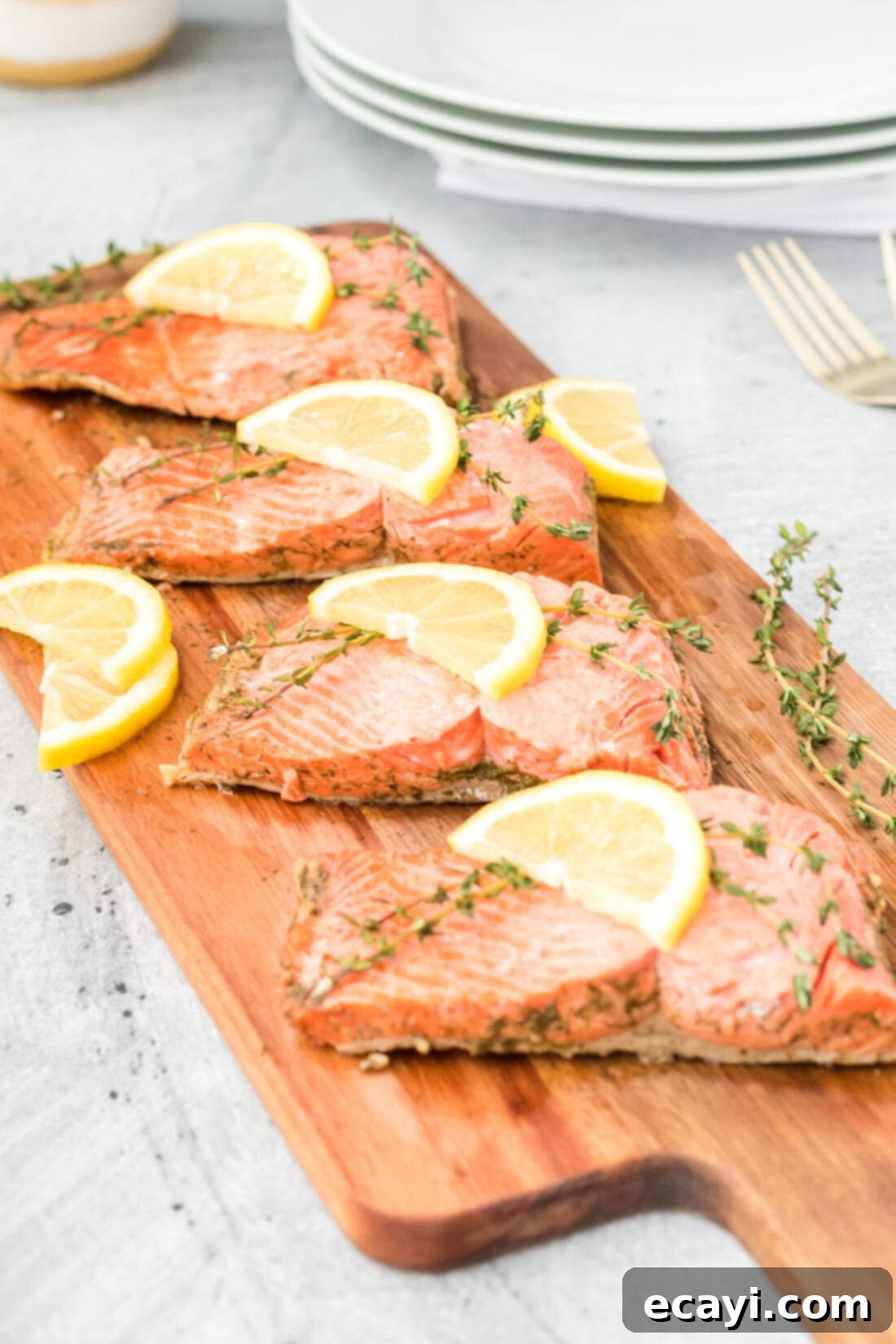
Delightful Serving Suggestions for Poached Salmon
Poached salmon, with its delicate flavor and moist texture, is incredibly versatile and pairs beautifully with a wide array of side dishes and sauces. Here are some ideas to inspire your next meal:
- Classic Accompaniments: Serve warm alongside steamed or roasted vegetables such as tender potatoes, glazed carrots, crisp broccoli, vibrant roasted green beans, or elegant asparagus. A simple squeeze of fresh lemon juice over the salmon and veggies is often all you need.
- Grain Bowls & Rice Dishes: For a more substantial meal, pair poached salmon with fluffy white rice, brown rice, quinoa, or couscous. Add some roasted vegetables for a complete and balanced bowl.
- Fresh Salads: Flake the cooled poached salmon into a fresh green salad with a light vinaigrette. It’s also fantastic in a Niçoise salad, or mixed with a creamy dressing for a delightful salmon salad sandwich or wrap.
- Creamy Sauces: Elevate your poached salmon with a rich sauce. A classic dill sauce, a light hollandaise, a lemon-butter sauce, or a refreshing Greek yogurt-dill sauce can add an extra layer of flavor.
- Mediterranean Inspired: Combine with cherry tomatoes, Kalamata olives, feta cheese, and a drizzle of olive oil for a Mediterranean-inspired dish.
- Breakfast/Brunch: Enjoy cold poached salmon with cream cheese, capers, and red onion on a bagel for a sophisticated brunch option.
- Pasta Dishes: Break the salmon into flakes and toss with pasta, a light cream sauce, peas, and a touch of lemon zest for a quick and elegant pasta dinner.
No matter how you choose to serve it, poached salmon offers a healthy, flavorful, and satisfying dining experience.
Explore More Delicious Salmon Recipes
If you’ve enjoyed this simple and healthy poached salmon recipe, you’ll be thrilled to discover the many other fantastic ways to prepare this versatile fish. From grilling to baking, and everything in between, salmon can be transformed into countless delicious meals. Expand your culinary repertoire with these additional salmon recipes:
- Grilled Salmon
- Salmon Tacos
- Baked Salmon
- Maple Soy Salmon
- Smoked Salmon Dip
- Cedar Plank Salmon
- Instant Pot Salmon
- Pan Seared Salmon
I love to bake and cook and share my kitchen experience with all of you! Remembering to come back each day can be tough, that’s why I offer a convenient newsletter every time a new recipe posts. Simply subscribe and start receiving your free daily recipes!
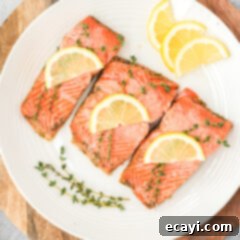
Poached Salmon
IMPORTANT – There are often Frequently Asked Questions within the blog post that you may find helpful. Simply scroll back up to read them!
Print It
Pin It
Rate It
Save ItSaved!
Ingredients
- 1 ½ pounds salmon fillets
- 1 Tablespoon dried dill or a sprig of fresh dill
- 1 small shallot sliced
- 1 cup water
- 1 Tablespoon lemon juice
- 1 teaspoon salt
- 1 teaspoon black peppercorns
- ½ Tablespoon minced garlic
- 1 Tablespoon liquid smoke (optional)
Things You’ll Need
-
Large skillet with lid
-
Fish turner
-
Vinyl gloves for handling raw salmon
Before You Begin
- Salmon is done cooking when it reaches an internal temperature of 145°F (63°C) on an instant-read thermometer that’s been inserted into the thickest part of the fillet.
- We used Sockeye salmon, which is thinner than other salmon varieties. For regular/thicker salmon fillets (like Atlantic or King), increase cooking time to 5 minutes.
- Store leftover poached salmon in an airtight container kept in the refrigerator for 2-3 days.
- Ensure your skillet is wide enough for salmon fillets to lie in a single layer to ensure even cooking.
Instructions
-
Place all ingredients for the poaching liquid (everything except the salmon) into a large skillet. Bring to a gentle boil over medium-high heat.
-
Carefully add the salmon fillets to the boiling water mixture, ensuring they are submerged. Reduce the heat to medium and cook, covered with a lid, for 2-3 minutes for Sockeye salmon, or 5 minutes for thicker salmon varieties.
-
Turn off the heat. Use a fish turner spatula to carefully lift the perfectly poached salmon out of the skillet and transfer it to a platter or plate. Serve immediately.
Nutrition
The recipes on this blog are tested with a conventional gas oven and gas stovetop. It’s important to note that some ovens, especially as they age, can cook and bake inconsistently. Using an inexpensive oven thermometer can assure you that your oven is truly heating to the proper temperature. If you use a toaster oven or countertop oven, please keep in mind that they may not distribute heat the same as a conventional full sized oven and you may need to adjust your cooking/baking times. In the case of recipes made with a pressure cooker, air fryer, slow cooker, or other appliance, a link to the appliances we use is listed within each respective recipe. For baking recipes where measurements are given by weight, please note that results may not be the same if cups are used instead, and we can’t guarantee success with that method.
